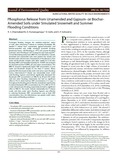| dc.contributor.author | Dharmakeerthi, R. S. | |
| dc.contributor.author | Kumaragamage, D. | |
| dc.contributor.author | Goltz, D. | |
| dc.contributor.author | Indraratne, S. P. | |
| dc.date.accessioned | 2020-10-22T08:22:11Z | |
| dc.date.available | 2020-10-22T08:22:11Z | |
| dc.date.issued | 2020-03-30 | |
| dc.identifier.citation | Dharmakeerthi, R. S., D. Kumaragamage, D. Goltz, and S. P. Indraratne. “Phosphorus Release from Unamended and Gypsum- or Biochar-Amended Soils under Simulated Snowmelt and Summer Flooding Conditions.” Journal of Environmental Quality 48(4) (July 2019):822–830. DOI: 10.2134/jeq2019.02.0091. | en_US |
| dc.identifier.uri | http://hdl.handle.net/10680/1848 | |
| dc.description.abstract | Prolonged flooding changes the oxidation–reduction status of soils, often enhancing P release to overlying floodwater. We studied P release from unamended, gypsum-amended, and biochar-amended soils under simulated snowmelt flooding (previously frozen, cold flooding at +4°C) and summer flooding (unfrozen, warm flooding at +22°C) using two soils, Fyala clay (FYL-Cl) and Neuenberg sandy loam (NBG-SL), from Manitoba, Canada. Amended and unamended soils were packed into vessels and flooded under cold and warm temperatures in the laboratory. Pore water and floodwater samples were taken weekly for 6 wk after flooding (WAF) and thereafter biweekly for 10 WAF and analyzed for dissolved reactive P (DRP), pH, and cation concentrations. The NBG-SL showed a significantly higher DRP concentration in pore water and floodwater despite its low Olsen P content. Redox potential (Eh) decreased slowly under cold versus warm flooding; hence, redox-induced P release was substantially lower under cold flooding. Gypsum amendment significantly decreased the floodwater DRP concentrations in NBG-SL by 38 and 35% under cold and warm flooding, respectively, but had no significant effect in FYL-Cl, which had low DRP concentrations (<1.2 mg L−1) throughout the flooding period. Biochar amendment significantly increased floodwater DRP concentrations by 27 to 68% in FYL-Cl under cold and warm flooding, respectively, but had no significant effect in NBG-SL. The results indicate substantially less P release under cold than under warm flooding. Gypsum was effective in reducing floodwater DRP concentrations only at high DRP concentrations; thus, the effectiveness was greater under warm than under cold flooding conditions. | en_US |
| dc.description.sponsorship | "Funding for this research was provided by a National Sciences and Engineering Research Council (NSERC) Discovery Grant and a University of Winnipeg Major Grant to Darshani Kumaragamage, and a fellowship awarded by the University of Winnipeg–Queen Elizabeth Advanced Scholar Program to R.S. Dharmakeerthi." | en_US |
| dc.description.uri | https://acsess.onlinelibrary.wiley.com/doi/10.2134/jeq2019.02.0091 | |
| dc.language.iso | en | en_US |
| dc.publisher | American Society of Agronomy, Crop Science Society of America, and Soil Science Society of America | en_US |
| dc.rights | info:eu-repo/semantics/openAccess | en_US |
| dc.subject | Phosphorus -- Environmental aspects | en_US |
| dc.title | Phosphorus Release from Unamended and Gypsum- or Biochar-Amended Soils under Simulated Snowmelt and Summer Flooding Conditions | en_US |
| dc.type | Article | en_US |
| dc.rights.license | Creative Commons Attribution-NonCommercial-NoDerivs | en_US |
| dc.identifier.doi | 10.2134/jeq2019.02.0091 | en_US |

